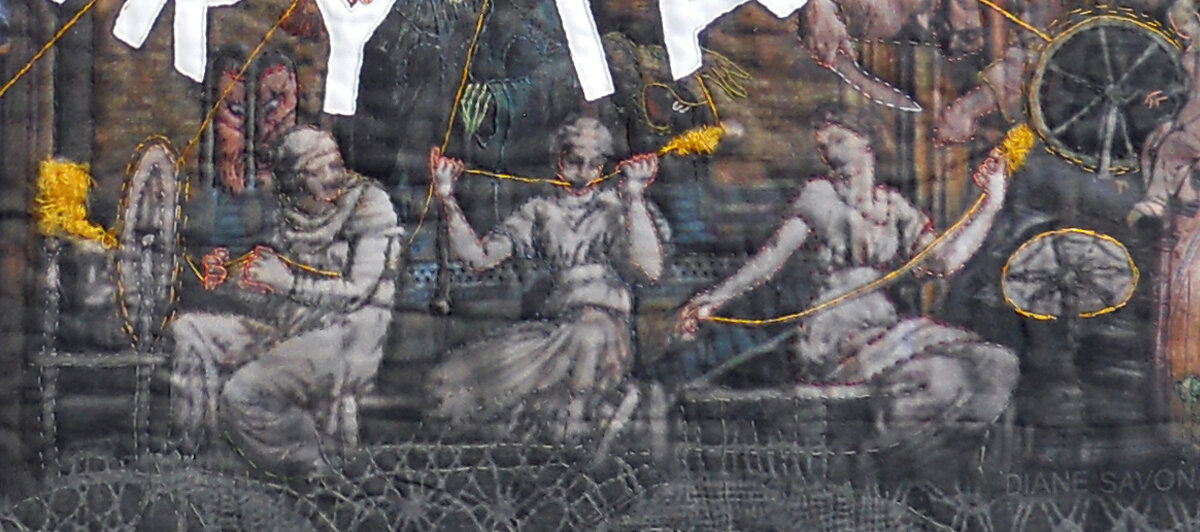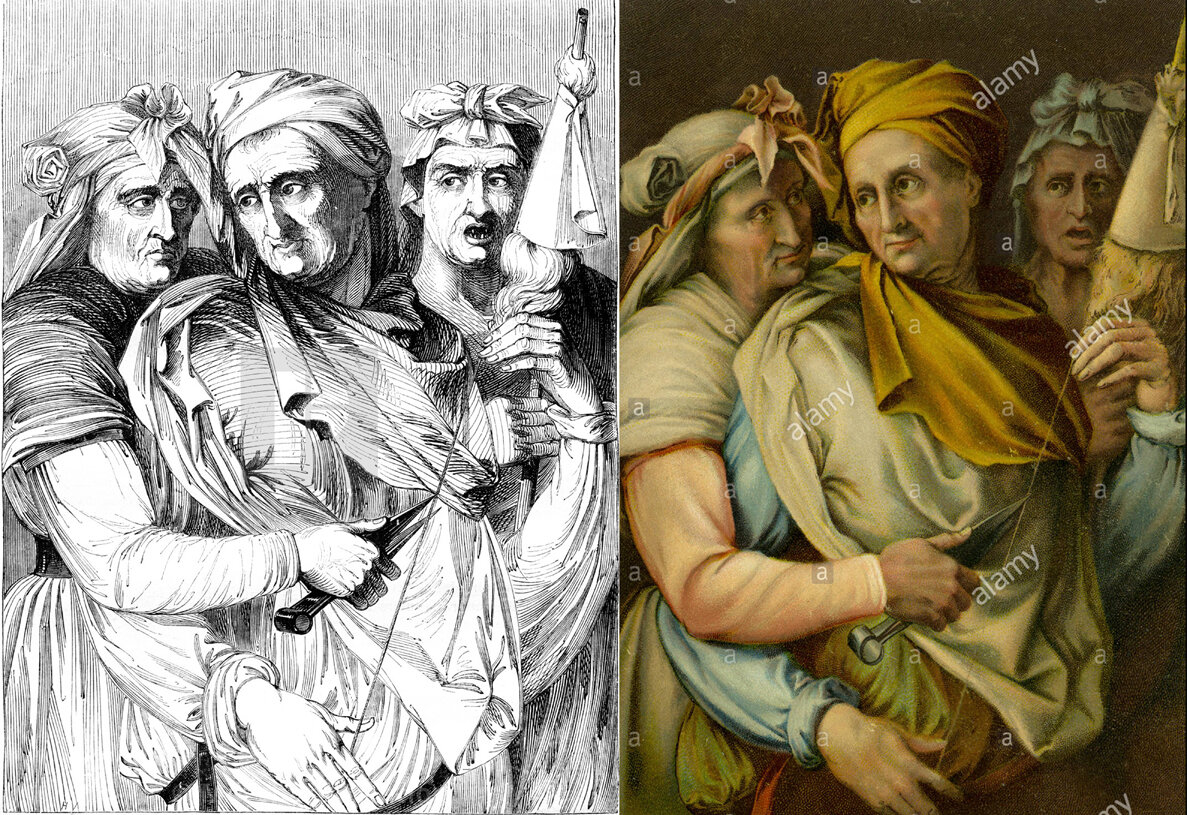Last week ended with these 3 fates, (below) who are now reincarnated as 3 ceramic fibulae. They will be sitting on the shoulder of the Jacket Quilt.
I had found them when I was gathering images to use for Fairy Tales, Part 1 (below)
But now, I cannot find this original image online anywhere. I’m pretty sure it’s by Walter Crane….but where did it go? Is it extinct online and I now have the only one in existence? The good news is that, while I was searching, I found so many interesting variations on the 3 fates. Take a look:
First, some identification. In ancient Greek mythology, the Moirai ( in English, the Fates) were the incarnations of destiny: Clotho (who spun out the thread of life), Lachesis (who measured the thread) and Atropos (who cut the thread). They controlled the thread of life from birth to death. But the depictions are rarely so clear-cut. Take a look (below):
So…a bit confusing.
(above) This print is tagged ”Ghisi After Giulio Romano, The Three Fates”. Which means that the original image was painted by Giulio Romano (1499 - 1546). In 1558, Giorgio Ghisi - an Italian reproductive engraver - made this print based on Romano’s painting. ….I found several copies of the print, but not one image of the original painting.
(above) The Three Fates by Hans Baldung Grien Germany, 1513, woodcut print. In addition to religious subjects, Baldung incorporated witches and witchcraft into his artwork. Don’t know if Hans is implying that these Fates are witches, but I found many other images where the implication was quite clear.
This image (above) of the fates was originally ascribed to Michelangelo. Now, it’s attributed to Francesco Salviati, a.k.a. Francesco de’ Rossi, also called Cecchino, 1510–1563 (“her name was McGill, but she called herself Lil, tho everyone knew her as Nancy…”). James Paul, at the @CuriousJamesPaul website, says that this is an etching created in the latter part of the 1800s. So who knows?
(above)…and then there are mosaics…with books, no scissors
(above)…and bas relief statuary….
(above)…and really hideous statues.
(above)….In this lovely Flemish tapestry from the 1500s, the 3 Fates represent Death triumphing over the body of Chastity… O..k.a..y. They couldn’t just cut her thread? Apparently, there are six allegorical tapestries based on a poem written by the poet Petrach. I was not interested enough to try to make further sense of this.
In 2009, artist Barbara Brackman (http://barbarabrackman.blogspot.com/2010/11/) used embroidery and altered photography for her own version (below).
Apparently Henry Moore made quite a few sketches for a sculpture of The Three Fates (below). There are more of his sketches at http://catalogue.henry-moore.org/objects/17340/the-three-fates.
When I looked for the finished sculpture, I couldn’t find one titled “The 3 Fates” . But there is one called Three Standing Figures 1945, cast c.1945-51 The Henry Moore Foundation says:
“Three Standing Figures” is a plaster maquette for the larger stone version of the sculpture in Battersea Park, London. While the poses and drapery of the figures allude to the subjects and forms of ancient classical art, the origins of the sculpture lie in Moore’s Shelter Drawings made during the Second World War, which has led critics to consider it as a representation of anxiety or watchfulness.” (below)
(below) and then we get to the fun stuff, like this image from Steve Hazard:
(below) and this linocut by Izzy Williamson - I LOVE all the extra hands!
(below) at the Atropos DC database, I found a comic book version:
At https://mywordlyobsessions.wordpress.com/2018/08/10/summer-reads-2-the-sandman-saga-by-neil-gaiman/ you can find information on the Sandman Saga, by Neil Gaiman. According to Gaiman, ”if the Moirai (the Three Fates) lived among us, they would be harmless old cat ladies with a penchant for yarn-bombing” (below).
While I was searching for my original Moirai image (which I never did find) I came across a site called God Checker….which is a tongue-in-cheek, rather eccentric online form of Cliff Notes for those of us who never paid attention in Comparative Religion class. Some definitions from their collection:
Egyptian gods : Made popular with the Book of the Dead and a thousand cheesy Curse of the Mummy movies, Ancient Egypt still holds its fascination in the modern world
Greek gods : What can we say about the Greek Gods that they haven’t already said about themselves? Consummate tall story tellers, the ancient Greeks had classy classic Gods for all situations.
Aztec gods: A host of interesting Gods with completely unpronounceable names. The Aztecs must have possessed the most dexterous tongues in the known world. By using Scrabble letters and adding the odd X you could probably make up your very own pantheon of Aztec deities.
Buddhism: Bored of reincarnation? Tired of the endless infinite cycle? Buddhism is the religion for you.
Japanese gods: Traditionally the Japanese have worshiped at least eight hundred myriads of gods, which must have caused a few congestion problems on their relatively small islands.
Norse gods: The red-blooded, rip-roaring, gung-ho Gods beloved by the Vikings. We could have listed them as Nordic, but ‘Norse’ sounds like the snorting of a giant battle stallion so we went for that.
Roman gods: What the Romans did for us was to encourage Godliness on a grand scale. You were spoilt for choice. Far from destroying the beliefs of conquered countries, they were actively encouraged - and in many cases absorbed. The Romans just couldn’t have enough Gods. In fact sometimes they appear to have invented some for special occasions.
more at https://www.godchecker.com/top-gods/


















